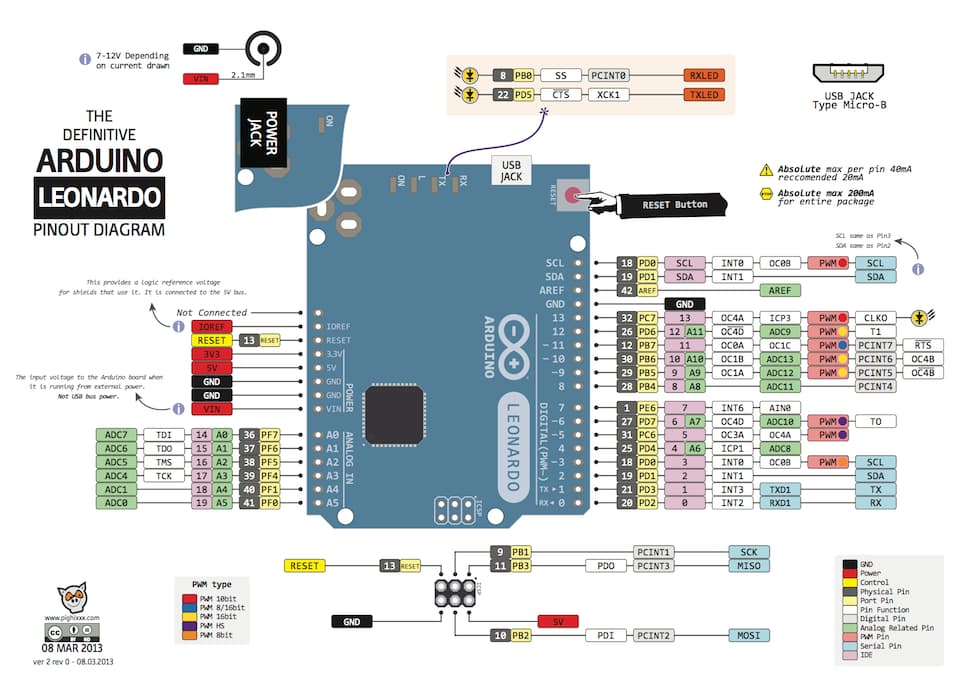Out Of Stock
Notify me when its in stock
Leonardo board is seperated from other Arduino boards by using ATmega32u4 microcontroller, Atmega32u4 is able to communicate with a computer directly thus it does not need an USB - Serial converter. Thanks to these features, Leonardo can be introduced to computer as not only virtual COM port but also as peripherals such as console and mouse too.
Original Arduino Leonardo Technical Features:

The Power of Original Arduino Leonardo:
Arduino Leonardo can be supplied via usb or an external voltage source. External voltage source would be an AC - DC adapter or a battery. When it is supplied with an external adapter or battery, using 2.1 mm width, center-positive, 7-20 V power supply is recommended. Moreover, the connectors of the power socket on the board, Vin and GND pins are short circuited in beckend. The battery can be connected to the board via GND and Vin pins. It is not necessary to be connected to usb port during whole the operation. The board can be energized with only an adapter or a battery too, by this way, the board can work independently from the computer. 6 - 20 V can be used as an external supply but these are the limits for Leonardo. Recommanded voltage supply for this board is between 7 - 20 V. Becouse the regulator on the board might not work stabile for the voltages below 7V. Likewise, it can be over - warmed for the voltages above 12 V. Operating voltage of the Arduino Leonardo's microcontroller is 5 V. The voltage supplies the board via Vin pin or the power socket on 7 to 12, V then this voltage is regulated and distributed to the board by the regulator.
Power pins are like that:
Original Arduino Leonardo Memory:
Atmega32u4 has an 32 kB flash memory (4 kB of this is used by the bootloader), 2.5 kB SRAM and 1 kB EEPROM.
Original Arduino Leonardo Input / Output:
All of the 20 digital pins on the Leonardo can be configured as output or input pins. The logic level for all of these pins is 5 V. These pins work with 40 mA input or output current. Additionally, some of these pins have diffrent features too, listed below:
You may view the page from this link.
Original Arduino Leonardo Communication:
There are several options for Arduino Leonardo to communicate with another arduino or microcontroller. Atmega32u4 provides UART TTL (5V) Serial communication via its 0 (RX) and 1 (TX) pins. 32u4 connects to a computer by opening a virtual serial COM port and allows the serial communication. Arduino IDE, thanks to its serial monitor find in the computer software, provides to send and recieve text based information. RX and TX leds on the board blink while the board is communicating via USB.
There is a phsycally serial port on the Leonardo board but this number can be increased with the SoftwareSerial library as software.
Atmega32u4 provides I2C and SPI ports too. Wire library if to use I2C and SPI library is for SPI communication.
Thanks to these features, Leonardo can be introduced to computer as not only virtual COM port but also as peripherals such as console and mouse too. You may visit Keyboard and Mouse classes page.
Original Arduino Leonardo Programming:
Arduino Leonardo board can be programmed with the Arduino computer software (Arduino IDE). You can start programming by choosing Arduino Leonardo under tools > board menu on the Arduino IDE. For details you may see the referance and the basic functions page. Atmega32u4 on the Arduino Leonardo board comes together with a specific software installed, named bootloader. Thanks to this it is not needed to use an external programming device to program Arduino Leonardo. Communication is supplied by and original AVR109 protocol.
The board can be programmed by using ICSP headers via ISP programmer instead of bootloader software (Referance).
Original Arduino Leonardo USB High Current Protection:
Arduino Leonardo board has restarable high current protectors. Even if your computer has its own protectors for its USB ports, the protectors on the board is adjusted to reject more than 500mA. If this amount of current is reached, protectors will keep open - circuit the connection untill the short - circuit disappears.
If you are not sure which Arduino to choose, you may contact us bu filling the form.
Links / Documents: